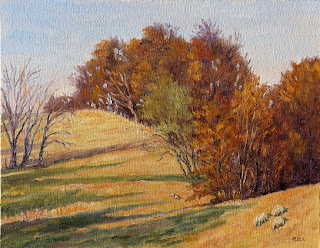 |
| The Patapsco River at McKeldin Area, oils on canvas panel, 9" x 12" |
Last weekend I went out to paint with a friend at the Mc Keldin Area of Patapsco State Park. It was a gorgeous morning, sunny and clear, with just a hint of fall in the air. We were at a trail just below the rapids where there is a wide pool before the river turns its course to flow through the forest.
I chose this view because the light coming through the leaves of this small sycamore maple was so lovely: the light breeze set the leaves to dancing and the water beyond glinted in the sunlight. I was working in oils and Mary Jo in watecolor; we worked on our paintings for about three hours, until the sun was high overhead. By this time huge clouds had gathered and the wind was picking up speed. Mary Jo didn't seem too happy with her painting--she doesn't use watercolors often--and I could see there were some problems with her work. Her strokes were much too much the same throughout the surface, with not enough color variation to give a sense of the space, of foreground and background.
After I got home and looked at my painting again, it seemed to me that mine had lost a good deal of that initial sense of light, of the warm light and shadows in the foreground against the cool background. This can easily happen as the light changes rapidly, and my work had clearly suffered from this confusion.
The next day I decided to paint the same scene, this time using watercolors, which I haven't worked much for the past year. I had some reference photos I had taken when I was finishing my oil painting.
 |
| The Patapsco River at McKeldin Area, watercolor, 10" x 14" |
I think the watercolor is much more successful than my oil (it's cooler in color overall, since the photo was taken as the sky was becoming overcast). The background in the watercolor remains more nebulous and cooler, while the foreground leaves, despite a soft focus, are in the proper relationship. The real difference, however, is the value of the tree-trunk, which should have been much darker and cooler in the oil to make it pop to the front. The distance should have been lighter and bluer in the oils to make it recede.
In the watercolor the softer darks on the left are more suggestive, it could be a footbridge or merely trunks, but they balance the darks of the tree trunk on the right, so the composition reads better. This illustrates perfectly a case where, as Mies Van de Rohe said, "Less is more." I must learn to restrain my impulse to put everything in minute detail into my paintings, in order to subordinate all other elements of the composition to the focal point. Somehow, I find this easier to do in watercolor than in oils. Could that be because I've learned to plan my watercolors more methodically or does the medium lend itself more to simplification? Hmmm...


























